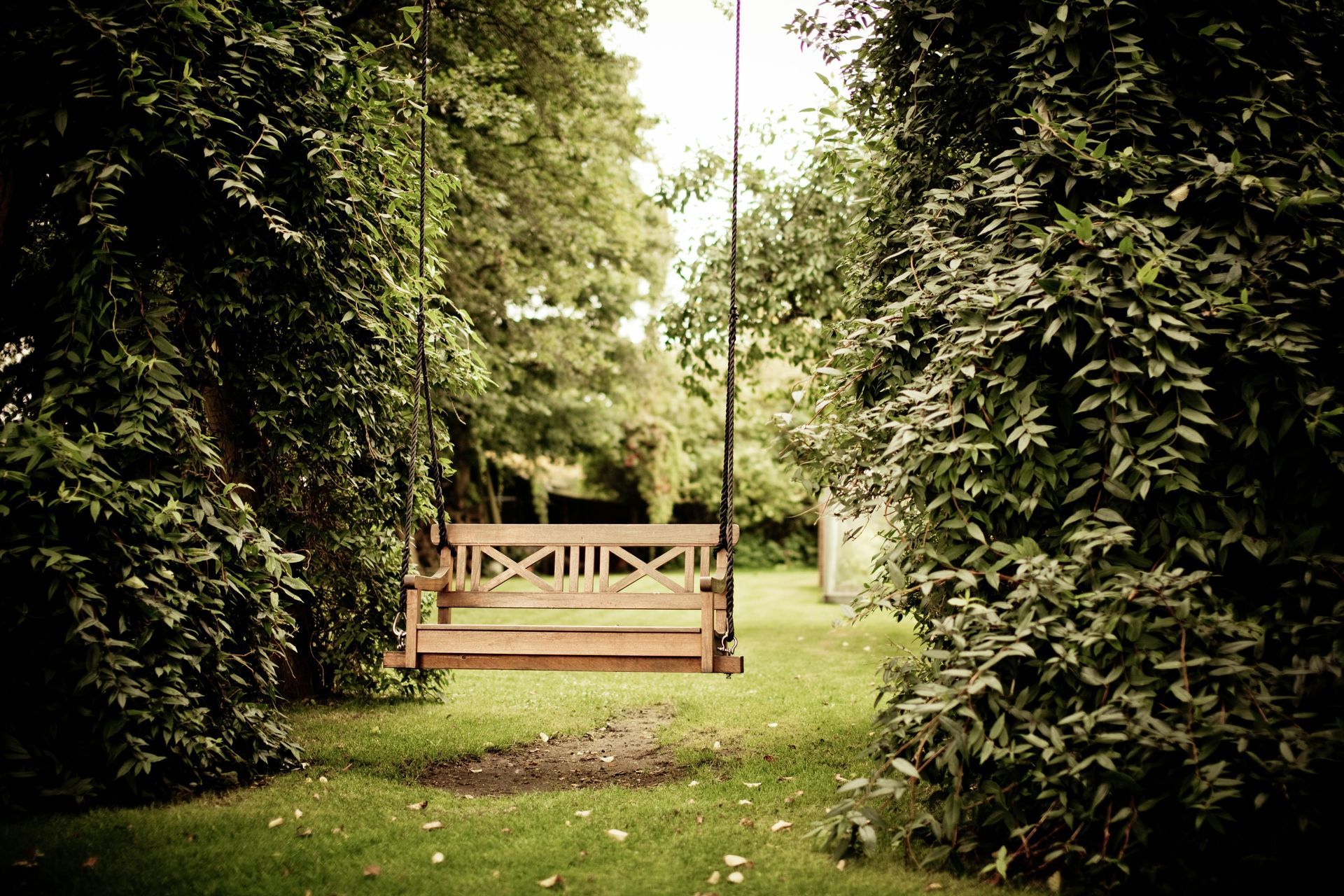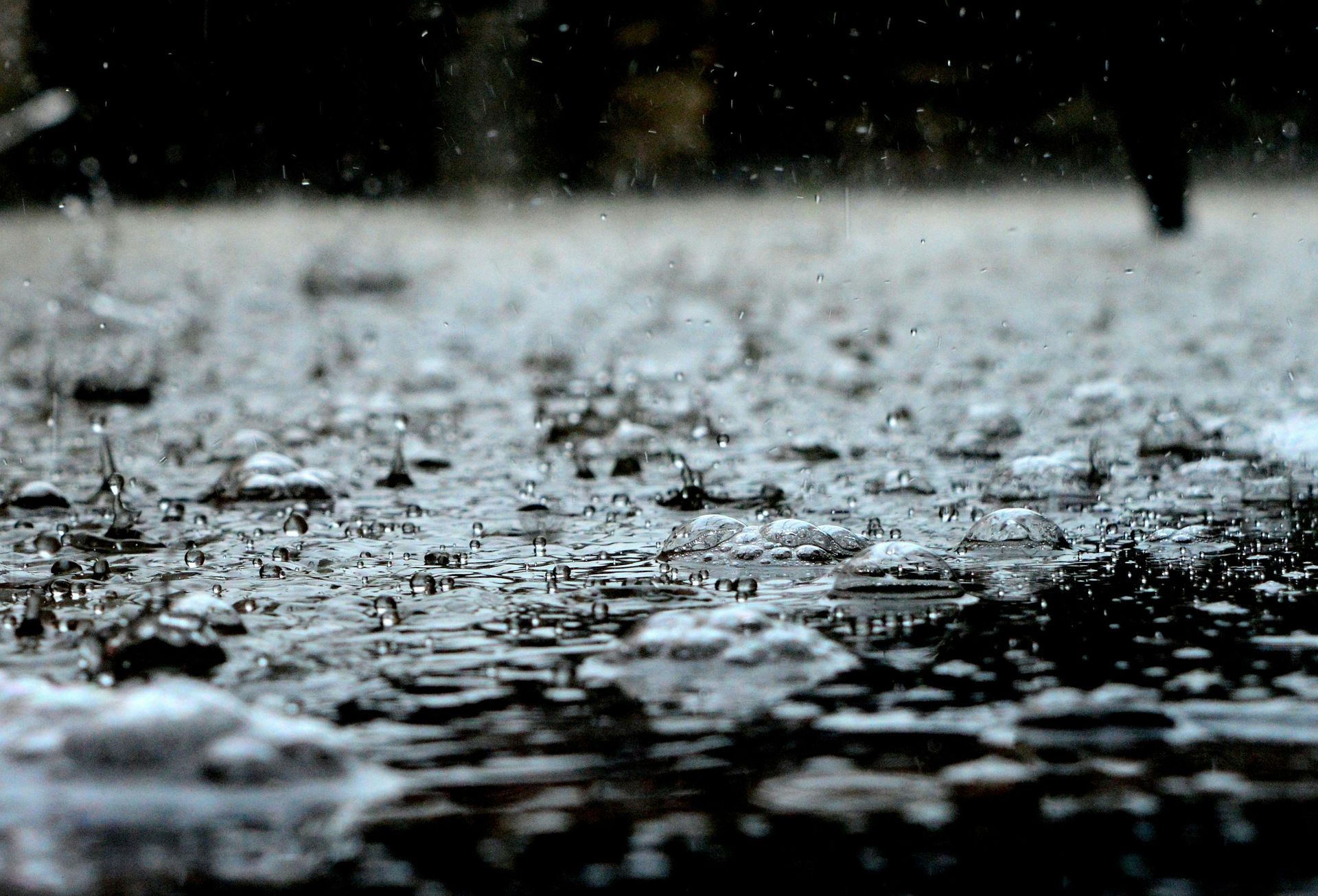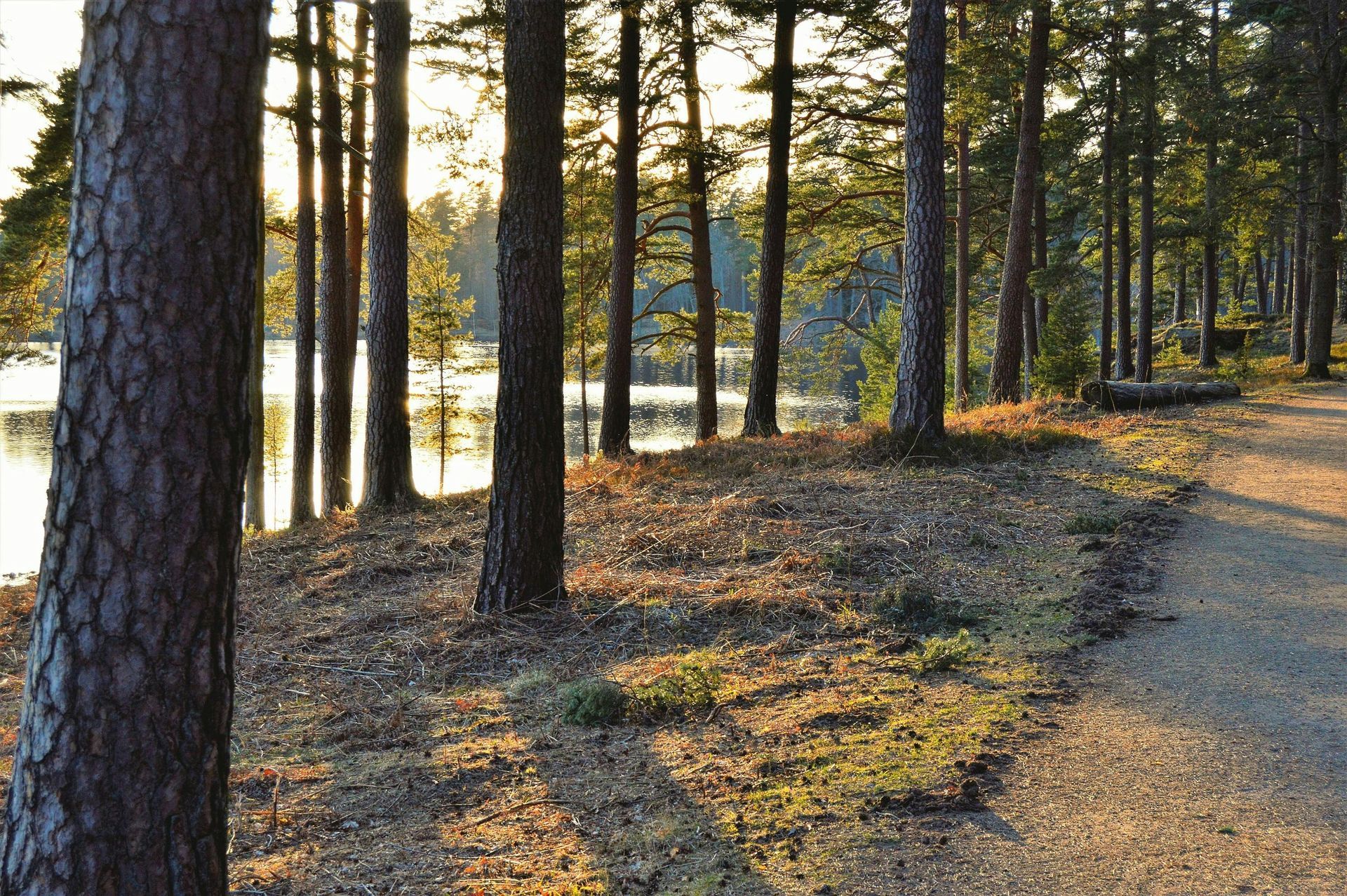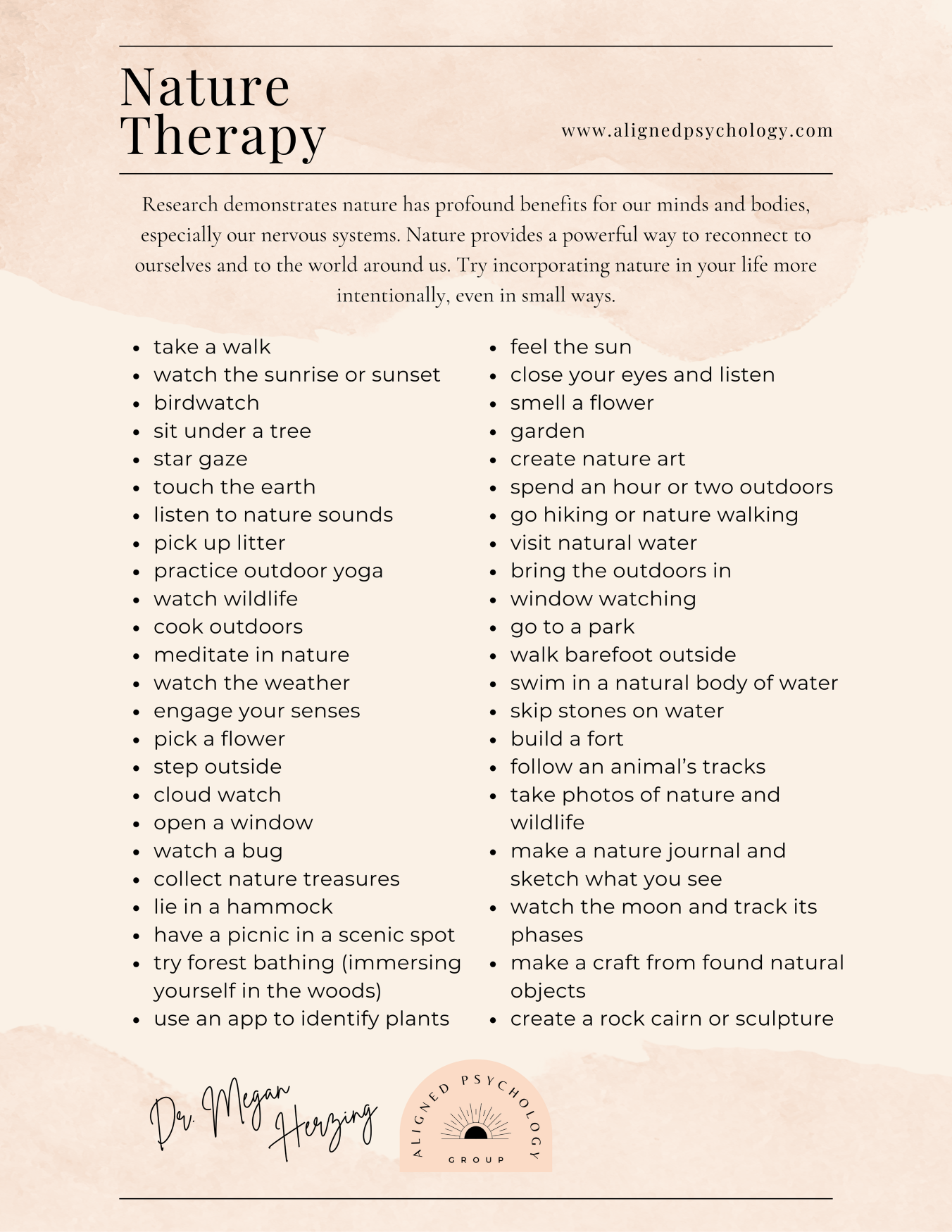Trauma Therapy Homework - Week 5
Week 5: (The Basics)
Nature Therapy
Nature has a unique way of grounding us, offering solace and connection when life feels overwhelming. For those navigating trauma or seeking a deeper sense of peace, nature therapy provides a gentle yet powerful way to reconnect with the world and ourselves. By incorporating nature into our lives, even in small ways, we can unlock its profound benefits for our mental and physical well-being. This blog explores how to weave nature into your daily routine, its effects on the nervous system, and creative ways to embrace the outdoors, regardless of the weather.

The Healing Power of Nature
Nature is not just a backdrop to our lives; it’s a dynamic force that nurtures our body, mind, and soul. Studies have shown that spending time in natural environments can lower stress levels, reduce anxiety, and improve overall mood. But why is nature so powerful?
The natural world engages our senses in ways that urban environments often cannot. The sound of birds chirping, the feel of grass beneath our feet, the sight of a blooming flower—these simple experiences can help anchor us in the present moment. For individuals recovering from trauma, this sensory grounding is invaluable, as it gently shifts focus away from distressing thoughts and toward a sense of safety and calm.
Small Ways to Bring Nature into Your Life
You don’t need to embark on a grand adventure to benefit from nature therapy. Here are some simple ways to infuse your daily life with the beauty and tranquility of the natural world:
Take a Walk: Stroll through a park, forest, or along a beach, focusing on the sights, sounds, and smells.
Watch the Sunrise or Sunset: Spend a few quiet moments appreciating the colors and atmosphere.
Birdwatch: Observe birds in your area or set up a bird feeder in your yard.
Sit Under a Tree: Relax in the shade of a tree and enjoy its tranquility.
Star Gaze: Look up at the night sky to identify constellations or simply enjoy the vastness.
Touch the Earth: Walk barefoot on grass, sand, or soil to ground yourself.
Listen to Nature Sounds: Pay attention to birdsong, rustling leaves, or running water.
Pick Up Litter: Help the environment by cleaning up a local green space.
Practice Outdoor Yoga: Move through yoga poses in a peaceful natural setting.
Watch Wildlife: Look for squirrels, insects, or other creatures in your area.
Cook Outdoors: Enjoy a picnic or barbecue in a scenic location.
Meditate in Nature: Find a quiet spot and practice mindfulness.
Watch the Weather: Enjoy the feel of rain, the warmth of the sun, or the crispness of a breeze.
Engage your senses: While walking your dog or strolling through your neighborhood, intentionally engage your senses.
Pick a Flower: During your next walk, take a moment to notice the flowers around you.
Step Outside: Spend a few moments outside, feeling the air on your skin and taking a deep breath.
Cloud Watch: Lie on your back or sit outside and watch the clouds drift by.
Open a Window: Let in fresh air and listen to the sounds of nature outside.
Watch a Bug: Observe an insect like a bee, butterfly, or ant going about its day.
Collect Nature Treasures: Pick up a unique rock, shell, or leaf to admire later.
Feel the Sun: Stand or sit in a sunny spot, letting the warmth soak into your skin.
Close Your Eyes and Listen: Spend a minute or two focusing on the natural sounds around you.
Smell a Flower: Pause to smell a blooming flower or crush some aromatic leaves like mint or lavender.
Garden: Plant flowers, vegetables, or herbs, and nurture them as they grow.
Create Art: Sketch, paint, or photograph natural scenes or objects.
Bigger Ways to Connect with Nature
When you have more time, consider immersing yourself in nature more deeply. These experiences can provide a sense of renewal and perspective that is hard to find elsewhere.
1. Spend an Hour or Two Outdoors
Whether it’s a local park, a nearby forest, or your own backyard, dedicate time to simply being in nature. Bring a book, journal, or just sit quietly and observe your surroundings.
2. Go Hiking or Nature Walking
Hiking allows you to explore nature more actively. Choose a trail that matches your fitness level and take your time to enjoy the journey.
3. Visit Natural Water
You can visit the beach, a lake, a stream, or any other bodies of natural water that you have access to. Put your feet in the water, splash it on your face, or notice the reflections of the sun on the surface.
The Benefits of Sunshine
Sunshine is one of nature’s most potent healers. Exposure to sunlight helps our bodies produce vitamin D, which supports bone health, immune function, and mood regulation. Sunlight also boosts serotonin levels, often referred to as the “happiness hormone,” which can improve mood and reduce symptoms of depression.
Whenever possible, aim to spend time outdoors during daylight hours. Even a few minutes of sun exposure can make a difference. If the weather isn’t ideal, try sitting near a window to soak up natural light.



Embracing Nature in Bad Weather
Rainy days, cold winters, or scorching heat shouldn’t stop you from reaping the benefits of nature. Here are some creative ways to connect with the outdoors, even when the weather isn’t cooperating:
1. Bring the Outdoors In
Succulents, ferns, and herbs are easy to care for and bring life to your space.
2. Weather-Appropriate Gear
A sturdy raincoat, warm boots, or a wide-brimmed hat can transform an uncomfortable outing into an enjoyable one.
3. Listen to Nature Sounds
If going outside isn’t feasible, listen to recordings of rain, ocean waves, or forest sounds. You can also open your window to hear the sounds of the rain.
4. Window Watching
Sit by a window and observe the world outside. Watch the rain fall, the wind move through the trees, or birds visiting a feeder.
Nature’s Impact on the Nervous System
Nature has a profound effect on the nervous system, helping to regulate the balance between the sympathetic (fight-or-flight) and parasympathetic (rest-and-digest) branches. Spending time in natural settings:
- Reduces Stress Hormones: Cortisol levels tend to drop in natural environments, promoting relaxation.
- Lowers Heart Rate and Blood Pressure: The calming effect of nature can help stabilize physiological markers of stress.
- Enhances Focus: Exposure to green spaces has been shown to improve attention and cognitive function.
- Promotes Mindfulness: Nature encourages us to slow down, breathe deeply, and engage with the present moment.
- For those recovering from trauma, these benefits are particularly significant. Nature provides a non-judgmental, restorative space where the nervous system can begin to heal.
Final Thoughts
Incorporating nature into your life doesn’t have to be complicated or time-consuming. Small acts, like smelling a flower or feeling the sun on your skin, can have a profound impact on your well-being. For those with more time, immersive experiences like hiking or spending an afternoon at the beach offer deeper connections and lasting benefits.
Nature therapy reminds us that healing is not about perfection but presence. By embracing the natural world, we can find balance, peace, and a renewed sense of connection to ourselves and the world around us. So, whether it’s a single flower on a morning walk or a weekend retreat in the woods, let nature guide you toward healing and mindfulness.

FREE Downloadable Handouts
Click this
LINK
for free access to downloadable PDFs from the Trauma Therapy Homework Series. You’ll be directed to my Google Drive folder, where you can explore all the handouts created so far. You can choose between a digital format for easy viewing on your device or a printable version if you prefer a hard copy.
Here is a preview of this week's handout! Click the link above to get your own free pdf copy.


ABOUT THE AUTHOR
Dr. Megan
Megan Herzing PsyD, Licensed Professional Clinical Counselor, specializes in trauma therapy and creating a safe, supportive space for healing. She integrates evidence-based modalities, including EMDR, Internal Family Systems (IFS), somatic therapy, and Emotionally Focused Therapy (EFT), to address the mind-body connection and empower clients on their journey to wellness. With extensive experience treating complex PTSD, anxiety, attachment injuries, and dissociation, she believes in the power of self-compassion and authentic connection to facilitate lasting change. Drawing from her own healing journey, she brings empathy and lived experience to her work, honoring each client’s unique path toward growth and resilience.
Thank you for being part of a community of humans that deeply cares about healing.
We are honored that you stopped by and hope our resources will continue to bring value to your life.
We are accepting new clients in California, and referrals are always appreciated.












